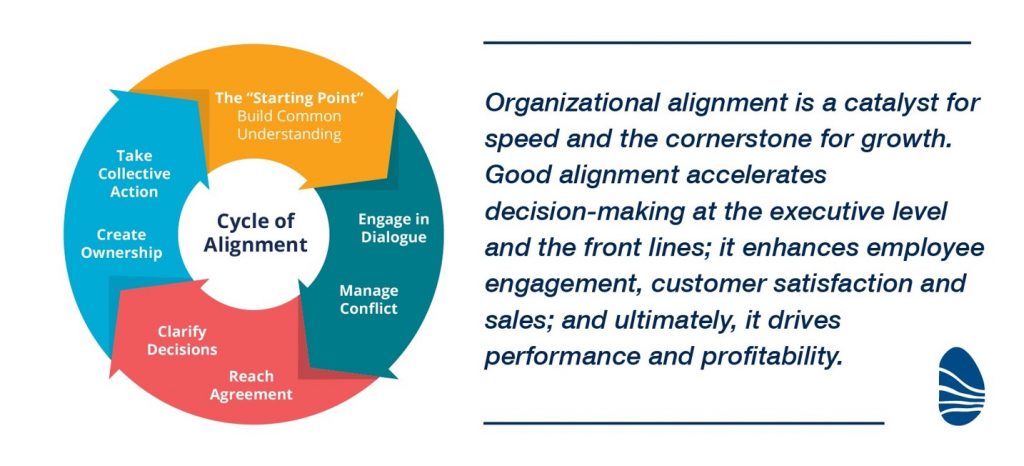For organizational alignment to carry forward and truly take hold, leaders across the enterprise must put in place processes that ingrain alignment into their daily work life.
It’s not enough to get aligned and perform well for a quarter or two; truly great organizations win year after year by reacting to—or, better yet, anticipating—internal and external changes. As your business improves— as you pick up speed and momentum—the alignment process must improve as well.
The Cycle of Alignment diagram is circular rather than linear because you can’t just stop after Taking Collective Action. That action yields results, and over time those results (in tandem with new market realities) must be monitored and assessed. With new data comes the need for a new Common Understanding, and the process begins again. Good operating mechanisms, however, can make subsequent runs through the Cycle more efficient and effective.
Keeping the Senior Team Aligned
Once alignment has been established and action is underway, the entire Senior Team must remain engaged in the effort. The responsibility for maintaining alignment cannot be passed off to one leader.
Some successful Senior Teams schedule monthly or quarterly half-day meetings, during which each leader reports on the progress of key strategic initiatives. The person accountable for the implementation of each initiative provides a brief progress report, notifies the group of any adjustments to the timeline, identifies any roadblocks that have appeared and asks for help from other Senior Leaders if necessary. These disciplined sessions ensure steady progress and keep all Senior Team members aligned.
These high-performing teams also set aside a larger block of time each year to analyze internal and external conditions and determine if any strategic changes are needed. One client starts this session with each leader grading (A through F) the Senior Team’s performance against each of its key measures and initiatives. Team members then use the assessment of the past year to plan for the year ahead, re-evaluating any incomplete strategic initiatives and recommending new ones. It is essential that the Senior Team—and the organization more generally—recognize that the strategy is not set in stone. It should be a “living document,” solid enough to drive tangible actions but also fluid enough to allow responses to internal and external shifts.
Keeping the Organization Aligned
It is also important that Senior Leaders seek ongoing input and engagement from the organization. Good Senior Teams create various opportunities throughout the year to share and get feedback on new strategies and initiatives, discuss external realities and internal capabilities, and build stronger networks across the organization. These sessions enable best practice sharing, cross-cultural understanding, and overall alignment; in effect, they nourish the environment necessary for alignment and serve as an early warning system for possible road bumps ahead.
One client provides a great example. After devoting two years to an alignment process that began with the Senior Team and cascaded into the regions, the CEO established an annual meeting of the company’s Top 200 leaders. During these “Global Leadership Forum” sessions, the Senior Team engages its key leaders from around the world in frank dialogue about strategy, culture, and customers. Now bolstered by related regional activities, the Forum enables the company to stay out in front of geographic and product shifts, capitalize on emerging growth opportunities, and maintain high service levels for its suppliers and customers. To be successful, operating mechanisms like this one must fit the business and drive discipline across the organization.
A variety of alignment meetings are possible, engaging different segments of the organization in groups of five to 500. Some teams like to invite external constituents, such as customers, suppliers, and shareholders. Regardless of the audience, these sessions work best when they’re well-thought-out and planned in advance. Leaders must take control of the organization’s calendars, rather than allowing the calendar to control them.
Keeping the Systems Aligned
For organizational alignment to carry forward and truly take hold, however, dedicated meetings are not enough. Leaders across the enterprise must put in place processes that ingrain alignment into their daily work life.
In the HR organization, for example, compensation, talent management, and hiring systems can be adjusted so they more closely align with the strategic roadmap. Case in point: Southwest Airlines. Having committed to a strategy of putting employees first (because they drive customer satisfaction), Southwest altered its interviewing process to ensure it hired only people with the right attitude and service ethic. By interviewing its star employees in each job function and identifying their common strengths, HR developed profiles to help them identify these top candidates.
HR isn’t the only area that can upgrade its systems. Finance leaders can develop a dashboard and reports that more clearly indicate performance against targets in key measures. IT executives can re-prioritize their portfolio of projects to align with strategic initiatives. Operating unit heads, with the support of Communications, can disseminate key messages to the front lines so the people who directly touch the customer are lined up with the Senior Team. Better yet, they can establish a mechanism that enables front-line employees to get important messages from the customers in front of the Senior Team.
Every leader in every part of the organization can establish operating mechanisms that enhance alignment. When these processes work well—and work together—the enterprise can make the adjustments necessary to respond to an ever-changing marketplace. With the right processes and the active attention of leadership, any organization can develop the flexibility, speed, and consistent execution that create a lasting competitive advantage.
Recommendations
- Assess how well your organization has done in relation to its strategic objectives for the year. Ask each member of your team to grade the group’s progress against each initiative. Which objectives have earned A’s—and why? Which are struggling to earn passing grades—and what additional support can be provided to ensure they succeed?
- How well-matched are your key operating mechanisms to the strategy? Ask members of your team to brainstorm ideas on where improvements can be made that will dramatically improve the execution of the strategy.








